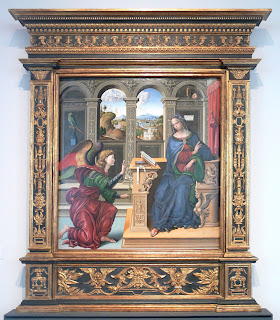When strolling through an art gallery or museum, as we look at a painting or photo, ideally, we do not notice the frame. Or, if we do, it's only for a moment before the work once more draws us back into its magical embrace. Somewhat less ideally, we consider that the frame should enhance the art work. And in a worst case scenario, the frame should at least not detract from its content. Beyond that, in a postmodern context, there are artists, myself included, who have incorporated the picture frame as a part of the content, accepting its aesthetic and cultural presence and purpose as a natural, inherent art commodity.
 |
| An early 1900s era frame shop by an unknown artist. |
 |
| An example of a one-piece carved frame from the 14th century. The artwork is an annunciation by an unknown artist. |
As to purpose, the picture frame's first duty is to protect the artwork. That may be simply a matter of keeping the edge of the painting from getting "dinged" or in providing support for glass or Lucite coverings which further protect the work. Of course, very often such framed work must be handled with great care to protect the frame, which, to my mind, somewhat defeats the purpose in framing, though a carefully protected frame, by definition would mean its artwork would also be protected. Historically, picture frames are a product of the Italian Renaissance, though an Egyptian fayum mummy portrait dating from the second century A.D. has been found with its wooden frame intact (preserved by the desert climate). Rare instances of one-piece carved frames from the 12th and 13th centuries also exist, especially in the case of religious icons.
Picture framing developed when art became portable. Thus religious altarpieces are some of the earliest examples that come to mind, in which the artist and his workshop created art and frame as the single entity. However, the real impetus for the "invention" of what we think of today as a picture frame came as the result of the growth of secular art in the sixteenth century. When wealthy Florentines, for example, commissioned wall decorations, they did so knowing that very often the art would last far longer than the wall. That fact of social and political life dictated some means of protecting their investment. As art grew in size (approaching that of the mural) picture framing became a major industry, taken over by furniture makers of the time. Even today, picture frames bear a sometimes uncomfortable relationship to the coffee table or the nightstand.
 |
| The "gallery wrap"--we don't need no stinkin' frames. |
 |
| Escaping Criticism, 1874, Pere Borrel del Caso |
In the Postmodern era, artist have come to accept the picture frame as, at worst, a necessary evil. Besides protecting art, the frame also serves as a dividing line between the improvised world created by the artist and the real, also improvised world of the viewer. The effort to cross this line, to, in effect, "break the frame" is largely a development of our present era, though examples, usually involving trompe l'oeil, can be found in art dating back to the 19th century Spanish painters such as Pere Borrel del Caso's Escaping Criticism (left). In this case, the frame is painted on the surface of the canvas. Dutch, English, and American painters have also played with this concept. In my own work, I've often extended the painting by various means out onto the frame, either by painting on the frame or through the use of various modeling media serving to three-dimensionally transition from the painting to the "real" world of the frame and the viewer. In my most recent work, The Peterhof Cascade (below), I glued to the lower portion of the painting a strip of primed canvas cut to imitate dripping water, then highlighted it would acrylic gel medium to extend the painted illusion of cascading water within the frame out over the frame. I'm thinking of placing a mop next to the painting.
 |
| The Peterhof Cascades, 2013, Jim Lane |
No comments:
Post a Comment